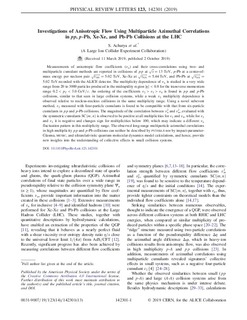Investigations of anisotropic flow using multiparticle azimuthal correlations in pp, p−Pb, Xe-Xe, and Pb-Pb collisions at the LHC
Acharya, Shreyasi; Adamová, Dagmar; Adhya, Souvik Priyam; Adler, Clemens; Adolfsson, Jonatan; Aggarwal, Madan M.; Aglieri Rinella, Gianluca; Agnello, Michelangelo; Agrawal, Nikita; Ahammed, Zubayer; Alme, Johan; Altenkaemper, Lucas; Djuvsland, Øystein; Ersdal, Magnus Rentsch; Fionda, Fiorella Maria Celeste; Grøttvik, Ola Slettevoll; Nystrand, Joakim; Rehman, Attiq ur; Røhrich, Dieter; Tambave, Ganesh Jagannath; Ullaland, Kjetil; Wagner, Boris; Yang, Shiming; Yuan, Shiming; Zhou, Zhuo; Arsene, Ionut Cristian; Bätzing, Paul Christoph; Dordic, Olja; Lardeux, Antoine Xavier; Lindal, Svein; Mahmood, Sohail Musa; Malik, Qasim Waheed; Richter, Matthias; Røed, Ketil; Skaali, Toralf Bernhard; Tveter, Trine Spedstad; Wikne, Jon Christopher; Zhao, Chengxin; Helstrup, Håvard; Hetland, Kristin Fanebust; Kileng, Bjarte; Nesbø, Simon Voigt; Storetvedt, Maksim Melnik; Langøy, Rune; Lien, Jørgen; Ahmad, Shafiq F.; Ahn, Sang Un; Aiola, Salvatore; Akindinov, Alexander; Al-Turany, Mohammed; ALICE, Collaboration
Journal article, Peer reviewed
Published version
Permanent lenke
http://hdl.handle.net/11250/2638466Utgivelsesdato
2019Metadata
Vis full innførselSamlinger
- Institutt for mikrosystemer [563]
- Publikasjoner fra CRIStin [3727]
Originalversjon
Physical Review Letters. 2019, 123:142301 (14), 1-13. 10.1103/PhysRevLett.123.142301Sammendrag
Measurements of anisotropic flow coefficients (vn) and their cross-correlations using two- and multiparticle cumulant methods are reported in collisions of pp at √s=13 TeV, p−Pb at a center-of-mass energy per nucleon pair √sNN=5.02 TeV, Xe-Xe at √sNN=5.44 TeV, and Pb-Pb at √sNN=5.02 TeV recorded with the ALICE detector. The multiplicity dependence of vn is studied in a very wide range from 20 to 3000 particles produced in the midrapidity region |η|<0.8 for the transverse momentum range 0.2v3>v4 is found in pp and p−Pb collisions, similar to that seen in large collision systems, while a weak v2 multiplicity dependence is observed relative to nucleus-nucleus collisions in the same multiplicity range. Using a novel subevent method, v2 measured with four-particle cumulants is found to be compatible with that from six-particle cumulants in pp and p−Pb collisions. The magnitude of the correlation between v2n and v2m, evaluated with the symmetric cumulants SC(m,n) is observed to be positive at all multiplicities for v2 and v4, while for v2 and v3 it is negative and changes sign for multiplicities below 100, which may indicate a different vn fluctuation pattern in this multiplicity range. The observed long-range multiparticle azimuthal correlations in high multiplicity pp and p−Pb collisions can neither be described by pythia 8 nor by impact-parameter-Glasma, music, and ultrarelativistic quantum molecular dynamics model calculations, and hence, provide new insights into the understanding of collective effects in small collision systems.
Beskrivelse
Published by the American Physical Society under the terms of the Creative Commons Attribution 4.0 International license. Further distribution of this work must maintain attribution to the author(s) and the published article’s title, journal citation, and DOI.

